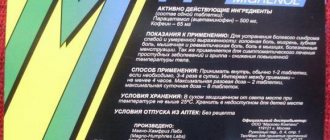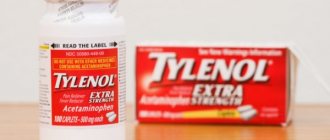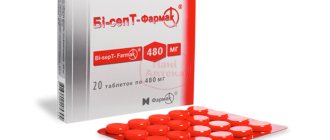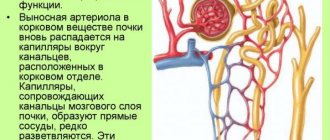Write a review
Reviews: 0
Manufacturers: Grunenthal (Germany)
Active ingredients
- Paracetamol
Disease class
- Acute pain
- Constant, unrelieved pain
- Other constant pain
Clinical and pharmacological group
- Not indicated. See instructions
Pharmacological action
- Painkiller
Pharmacological group
- Opioid non-narcotic analgesics in combinations
Pharmacodynamics and pharmacokinetics
Tramadol is opioid analgesic Stimulates opioid receptors on the pre- and postsynaptic walls of the afferent processes of cells of the nociceptive system in the digestive tract and in the brain. It has the following effects on the brain and spinal cord: hyperpolarizes membranes and blocks the conduction of pain impulses, helps open sodium and calcium channels. Enhances the effects of sedatives.
Paracetamol lowers the temperature and relieves pain. Suppresses cyclooxygenase in the nervous system, acting on the centers of thermoregulation and pain. Does not irritate the mucous membranes of the stomach and intestines, does not affect mineral metabolism, because it does not affect the synthesis of prostaglandins in the tissues of peripheral organs.
Paracetamol provides a rapid onset of analgesic effect, and tramadol prolongs this effect. The synergism of the analgesic effect of these components reduces the risk of developing undesirable effects.
Pharmacokinetics
After consumption, the active components are immediately absorbed from the intestines. Tramadol absorption occurs more slowly than paracetamol . The highest concentration of paracetamol in the blood is recorded after an hour and does not change when used simultaneously with tramadol .
The bioavailability of tramadol reaches 75%; with repeated use it can reach up to 90%. Plasma protein binding for tramadol is 20%; for paracetamol binding values are approximately the same.
Tramadol undergoes metabolism in the liver to form 11 metabolites, only one of which ( mono-O-desmethyltramadol ) demonstrates pharmacological activity. paracetamol component is also metabolized mainly in the liver. The half-life of tramadol reaches five hours, and paracetamol is three hours. Tramadol, paracetamol and their metabolites are excreted primarily by the kidneys.
pharmachologic effect
Combined drug with analgesic effect.
Tramadol is a synthetic opioid analgesic, an opioid receptor agonist. Activates opioid receptors (mu-, delta-, kappa-) on the pre- and postsynaptic membranes of afferent fibers of the nociceptive system in the brain and gastrointestinal tract. It has an effect on the brain and spinal cord: it promotes the opening of K+ and Ca2+ channels, causes hyperpolarization of membranes and inhibits the conduction of pain impulses. Strengthens the effect of sedatives.
Paracetamol is an analgesic-antipyretic. Blocks cyclooxygenase in the central nervous system, affecting pain and thermoregulation centers. Does not cause irritation to the mucous membrane of the stomach and intestines, does not affect water-salt metabolism, since it does not affect the synthesis of prostaglandins in peripheral tissues.
Paracetamol provides a rapid onset of analgesic effect, while tramadol prolongs analgesia. The synergism of the analgesic effect of the two components reduces the risk of side effects.
Contraindications
- Sensitization to the components of the drug;
- acute intoxication with drugs that suppress the nervous system ( hypnotics, opioids or psychotropic drugs) or alcohol;
- severe liver or kidney damage;
- simultaneous administration with MAO inhibitors and a two-week period after their discontinuation;
- uncontrolled epilepsy ;
- age less than 14 years;
- withdrawal syndrome .
Zaldiar should be used with caution in patients with traumatic brain injury , in a state of shock , with intracranial hypertension , a tendency to convulsions , cryptogenic confusion, impaired respiratory function, simultaneous use with psychotropic drugs, other painkillers of central and local action, benign hyperbilirubinemia , diseases hepatobiliary system, viral hepatitis , deficiency of glucose-6-phosphate dehydrogenase , alcoholism , alcoholic changes in the liver, drug addiction , with symptoms of “ acute abdomen ” of unknown origin, in the elderly.
special instructions
Patients should be informed of the need for strict adherence to the dosage regimen. While taking Zaldiar, you should not use other drugs containing tramadol or paracetamol without a doctor's prescription.
With prolonged uncontrolled use of Zaldiar, symptoms of drug dependence may appear (irritability, phobias, nervousness, sleep disturbances, psychomotor activity, tremor, gastrointestinal discomfort). If the drug is abruptly discontinued, signs of withdrawal syndrome may appear.
For patients with a tendency to abuse or develop dependence, treatment should be carried out under close medical supervision for a short period of time.
During treatment with Zaldiar, alcohol intake is prohibited. The risk of developing liver dysfunction increases in patients with alcoholic hepatosis.
During long-term use of the drug Zaldiar, monitoring of the peripheral blood picture and the functional state of the liver is necessary.
Impact on the ability to drive vehicles and operate machinery
During treatment with Zaldiar, you should refrain from driving vehicles and engaging in potentially hazardous activities that require increased concentration and speed of psychomotor reactions.
Side effects
- From the nervous system: increased fatigue, headache, dizziness, weakness, nervousness, anxiety, spasms , emotional lability, euphoria, hallucinations, lethargy, sleep disturbance, incoordination , confusion, depression , deterioration of cognitive function, amnesia , gait instability, paresthesia , blurred vision or taste;
- allergic reactions: itching , urticaria , angioedema ;
- reactions from the digestive system: vomiting or nausea, dry mouth, flatulence , constipation , abdominal pain, diarrhea , activation of liver enzymes, difficulty swallowing;
- reactions from the hormonal system: hypoglycemia ;
- reactions from the circulatory system: fainting, orthostatic hypotension, tachycardia, collapse ;
- reactions from the respiratory system: dyspnea ;
- reactions from the genitourinary system: dysuria , urinary retention, possible nephrotoxicity if recommended doses are exceeded for a long time;
- skin reactions: bullous rash, exanthema, erythema multiforme, Lyell's syndrome;
- reactions from hematopoiesis: sulfhemoglobinemia , possible appearance of pancytopenia, aplastic anemia, agranulocytosis with prolonged excess of recommended doses;
- other reactions: increased sweating, changes in the menstrual cycle.
Instructions for use of Zaldiar (Method and dosage)
Instructions for use of Zaldiar recommend swallowing the tablets whole, without chewing and drinking water, and does not advise connecting the use of the drug with food intake. If you missed taking the next pill, you should not double the dosage the next time you take it.
The dosage regimen is set individually, as is the duration of treatment, depending on the degree of pain and the patient’s condition.
For adults and children over 14 years of age, the initial single dose is set at 1-2 tablets, the time between doses of such doses is six hours. The highest daily dose is 8 tablets, which corresponds to 2.6 g of paracetamol and 300 mg of tramadol.
Similar drugs:
- Serrata Oral tablets
- Ibufen Oral suspension
- Meloflex Rompharm Solution for intramuscular administration
- Dollar () Oral tablets
- Ketanov Oral tablets
- Synmeton (SYNMETON) Oral tablets
- Novalgin Oral tablets
- Milistan Caplets
- Spasmalin Solution for injection
- Aspirin Oral tablets
** The Drug Directory is intended for informational purposes only. For more complete information, please refer to the manufacturer's instructions. Do not self-medicate; Before starting to use the drug Zaldiar, you should consult a doctor. EUROLAB is not responsible for the consequences caused by the use of information posted on the portal. Any information on the site does not replace medical advice and cannot serve as a guarantee of the positive effect of the drug.
Are you interested in the drug Zaldiar? Do you want to know more detailed information or do you need a doctor's examination? Or do you need an inspection? You can make an appointment with a doctor - the Euro lab is always at your service! The best doctors will examine you, advise you, provide the necessary assistance and make a diagnosis. You can also call a doctor at home . Euro lab clinic is open for you around the clock.
** Attention! The information presented in this medication guide is intended for medical professionals and should not be used as a basis for self-medication. The description of the drug Zaldiar is provided for informational purposes and is not intended for prescribing treatment without the participation of a doctor. Patients need to consult a specialist!
If you are interested in any other drugs and medications, their descriptions and instructions for use, information about the composition and form of release, indications for use and side effects, methods of use, prices and reviews of drugs, or you have any other questions and suggestions - write to us, we will definitely try to help you.
Overdose
Signs of tramadol : vomiting, miosis, collapse, depression of the respiratory center, convulsions, coma, apnea.
Signs of paracetamol : diarrhea , loss of appetite; if recommended doses are exceeded for 2-4 days - hypocoagulation, cerebral edema, disseminated intravascular coagulation syndrome, metabolic acidosis, hypoglycemia, arrhythmia, collapse . Rarely, fulminant development of liver dysfunction, including renal failure .
Therapy: gastric lavage, administration of enterosorbents , control and normalization of parameters of the cardiovascular and respiratory systems.
In case of respiratory depression (as a symptom of tramadol ), administration of naloxone ; for convulsions - use diazepam . Hemodialysis or hemofiltration are ineffective for the removal of tramadol .
If signs of paracetamol , it is recommended to administer precursors for glutathione and SH-group donors ( methionine ).
Pharmacokinetics
Suction
After oral administration, the active components are quickly and almost completely absorbed from the gastrointestinal tract. Tramadol is absorbed more slowly than paracetamol.
Cmax of paracetamol in blood plasma is achieved within 1 hour and does not change when used together with tramadol. The bioavailability of tramadol is approximately 75%, increasing to 90% with repeated use.
Distribution
Plasma protein binding of tramadol is about 20%, Vd is about 0.9 l/kg. A relatively small part (up to 20%) of paracetamol binds to plasma proteins.
Metabolism
Tramadol is metabolized in the liver by N- and O-demethylation followed by conjugation with glucuronic acid. 11 metabolites have been identified, of which mono-O-desmethyltramadol (M1) has pharmacological activity.
Paracetamol is metabolized primarily in the liver.
Removal
The average T1/2 of tramadol metabolite is 4.7-5.1 hours, T1/2 of paracetamol is 2-3 hours.
Tramadol (about 30%) and its metabolites (about 60%) are excreted primarily in the urine. Paracetamol and its conjugates are also excreted in the urine.
Interaction
When used together with other drugs that depress the nervous system ( hypnotics or tranquilizers ), as well as with ethanol , undesirable effects may occur.
When used simultaneously with opioid agonists-antagonists ( nalbuphine, buprenorphine, pentazocine ), the analgesic effect is reduced due to a competing effect and there is a risk of withdrawal syndrome . This combination is not desirable.
Inducers of microsomal oxidation ( phenytoin, carbamazepine, phenylbutazone, ethanol, rifampicin, barbiturates, tricyclic antidepressants ) weaken the analgesic effect of the drug and its duration.
Naloxone activates breathing and eliminates the analgesia caused by Zaldiar.
Inhibitors of microsomal oxidation, when used together, reduce the likelihood of developing hepatotoxic effects from taking Zaldiar.
Long-term use of barbiturates reduces the effectiveness of paracetamol.
Use with tricyclic antidepressants , selective serotonin reuptake blockers, and antipsychotics may increase the risk of seizures.
Long-term combined use with other non-steroidal anti-inflammatory drugs increases the risk of nephropathy and papillary necrosis of the kidneys , the onset of the final stage of renal failure .
Simultaneous long-term administration of high doses of paracetamol and salicylates increases the risk of bladder or kidney cancer .
Diflunisal increases the concentration of paracetamol in the blood by 50%, while simultaneously increasing the risk of hepatoxicity.
With simultaneous long-term use with indirect anticoagulants , their effects are enhanced, which increases the likelihood of bleeding.
Oral tablets Zaldiar
Instructions for medical use of the drug
Description of pharmacological action
Tramadol is a synthetic opioid analgesic, has an analgesic effect, and is an agonist of opiate receptors. It has a central effect and an effect on the spinal cord (promotes the opening of K+ and Ca+ channels, causes hyperpolarization of membranes and inhibits the conduction of pain impulses), enhances the effect of sedatives. Activates opiate receptors (mu-, delta-, kappa-) on the pre- and postsynaptic membranes of afferent fibers of the nociceptive system in the brain and gastrointestinal tract. Paracetamol - has an analgesic and antipyretic effect. Blocks COX in the central nervous system, affecting the centers of pain and thermoregulation. Does not cause irritation to the mucous membrane of the stomach and intestines, does not affect water-salt metabolism, since it does not affect the synthesis of PG in peripheral tissues. Paracetamol provides rapid pain relief, while tramadol provides a prolonged effect. The synergism of the analgesic effect of the two active substances reduces the risk of side effects.
Indications for use
Pain syndrome (moderate and severe intensity of various etiologies, including inflammatory, traumatic, vascular origin); Pain relief during painful diagnostic or therapeutic procedures.
Release form
Film-coated tablets; blister 10 cardboard pack 1; Film-coated tablets; blister 10 cardboard pack 2; Film-coated tablets; blister 10 cardboard pack 5; Film-coated tablets; blister 10 cardboard pack 3;
Pharmacodynamics
Zaldiar is a combined pain reliever containing tramadol and paracetamol. Tramadol is an analgesic of the synthetic opioid group (opioid receptor agonist). Acts on μ-, κ-, δ-opioid receptors of the nociceptive system of the brain and gastrointestinal tract through their activation at the level of pre- and postsynaptic membranes of afferent fibers. It acts on membrane polarization, opening potassium and calcium channels, which causes hyperpolarization and inhibits the conduction of pain impulses. Potentiates the effect of sedatives. Paracetamol is an analgesic with antipyretic properties. Affects pain and temperature centers of the brain by deactivating cyclooxygenase. It does not affect the prostaglandin synthetic function of peripheral tissues, therefore it does not have an irritating effect on the gastrointestinal mucosa and does not affect water-electrolyte metabolism. Tramadol prolongs the rapid analgesic effect of paracetamol. The two components act synergistically, which reduces the likelihood of side effects.
Pharmacokinetics
The components of the drug are quickly and almost completely absorbed from the gastrointestinal tract (tramadol absorption is somewhat slower than paracetamol). Tramadol is metabolized in the liver by N- and O-demethylation followed by conjugation with glucuronic acid. 11 metabolites have been identified, of which mono-O-desmethyltramadol (M1) has pharmacological activity. The average T1/2 for the tramadol metabolite is 4.7-5.1 hours, for paracetamol - 2-3 hours. Cmax in the blood plasma of paracetamol is achieved within 1 hour and does not change when used together with tramadol. The bioavailability of tramadol is approximately 75%; with repeated use, the bioavailability increases to 90%. Plasma protein binding is about 20%, volume of distribution is about 0.9 l. A relatively small part (up to 20%) of paracetamol binds to plasma proteins. Tramadol (about 30%) and its metabolites (about 60%) are excreted from the body mainly through the kidneys. Paracetamol is predominantly metabolized in the liver. Paracetamol and its conjugates are excreted by the kidneys.
Use during pregnancy
Should not be used during pregnancy and breastfeeding.
Contraindications for use
- hypersensitivity to the active components and excipients of the drug; - general intoxication with alcohol, drugs that depress the central nervous system, sleeping pills, narcotic analgesics and psychotropic drugs; - simultaneous use of MAO inhibitors (and 2 weeks after their discontinuation); - severe liver and/or kidney failure (creatinine Cl less than 10 mg/l); - epilepsy not controlled by treatment; - drug withdrawal syndrome; - children's age (up to 14 years). With caution: - state of shock; — TBI; - intracranial hypertension; - tendency to convulsive syndrome (in patients with epilepsy controlled by medication, the drug can be used only for health reasons); - confusion of unknown etiology; - respiratory dysfunction; - simultaneous use of psychotropic and other centrally acting analgesics, local anesthesia; - diseases of the biliary tract; - benign hyperbilirubinemia; - viral hepatitis; - deficiency of glucose-6-phosphate dehydrogenase; - alcoholic liver damage; - alcoholism; - drug addiction; - pain in the abdominal cavity of unknown origin (“acute abdomen”); - old age (over 75 years).
Side effects
Allergic reactions: urticaria, itching, angioedema, exanthema, bullous rash. From the nervous system: dizziness, headache, weakness, increased fatigue, lethargy, paradoxical stimulation of the central nervous system (nervousness, agitation, anxiety, tremors, muscle spasms, euphoria, emotional lability, hallucinations), drowsiness, sleep disturbance, confusion, impaired coordination movements, convulsions of central origin (with simultaneous prescription of antipsychotic drugs), depression, amnesia, impaired cognitive function, paresthesia, gait instability. From the digestive system: dry mouth, nausea, vomiting, flatulence, abdominal pain, constipation, diarrhea, difficulty swallowing; increased activity of liver enzymes, usually without the development of jaundice. From the cardiovascular system: tachycardia, orthostatic hypotension, syncope, collapse. From the endocrine system: hypoglycemia, up to hypoglycemic coma. From the urinary system: difficulty urinating, dysuria, urinary retention; with long-term use in doses significantly higher than recommended - nephrotoxicity (interstitial nephritis, papillary necrosis). From the senses: disturbances of vision, taste. From the respiratory system: dyspnea. From the skin: exudative erythema multiforme (including Stevens-Johnson syndrome), toxic epidermal necrolysis (Lyell's syndrome). From the hematopoietic organs: sulfohemoglobinemia; with long-term use in doses significantly higher than recommended - aplastic anemia, pancytopenia, agranulocytosis. Other: sweating, menstrual irregularities. With prolonged use - the development of drug dependence. With abrupt withdrawal - withdrawal syndrome.
Directions for use and doses
Inside, regardless of food intake, whole (cannot be broken or chewed), washed down with liquid. It is used under the supervision of a physician; the dosage regimen and duration of treatment are selected individually depending on the severity of the pain syndrome and the sensitivity of the patient. The drug should not be prescribed for longer than is justified from a therapeutic point of view. For adults and children over 14 years of age, the recommended initial dose is 1–2 tablets, the interval between doses of the drug is at least 6 hours. The maximum daily dose is 8 tablets. (300 mg tramadol and 2.6 g paracetamol). If the patient forgets to take the next pill, then the next one is taken as recommended by the doctor. Do not double the dose to make up for a missed dose. In elderly patients (over 75 years of age), normal doses may be used. However, due to the possibility of delayed elimination, the interval between doses of the drug may be increased. In patients with renal failure (Cl creatinine from 10 to 30 ml/min), the drug should be taken at 12-hour intervals between doses. Since tramadol is eliminated very slowly during hemodialysis or hemofiltration, post-dialysis use to maintain analgesic effect is usually not required. The drug is not used in patients with severe liver dysfunction. In case of moderate liver dysfunction, the interval between doses of the drug should be increased. The risk of paracetamol overdose is higher in patients with liver damage of alcoholic etiology.
Overdose
In cases of acute overdose, symptoms may include signs of tramadol or paracetamol overdose. Tramadol overdose: miosis, vomiting, collapse, coma, convulsions, depression of the respiratory center up to apnea. Overdose of paracetamol: acute overdose develops 6-14 hours after administration, chronic overdose - after 2-4 days. Symptoms of acute overdose: diarrhea, loss of appetite. Symptoms of chronic overdose: cerebral edema, hypocoagulation, development of disseminated intravascular coagulation syndrome, hypoglycemia, metabolic acidosis, arrhythmia, collapse; Rarely, liver dysfunction develops at lightning speed and can be complicated by renal failure (renal tubular necrosis). Treatment: usual emergency measures. It is recommended to lavage the stomach and take enterosorbents (activated carbon, polyphepan), maintain the function of the cardiovascular system, and ensure airway patency. Naloxone is used to relieve respiratory depression as a symptom of tramadol overdose. Convulsions that occur at toxic dosages can be eliminated with diazepam. Tramadol is minimally removed from the serum by hemodialysis or hemofiltration, so carrying out only these measures for the treatment of overdose is ineffective. If symptoms of paracetamol overdose appear: administration of SH-group donors and precursors for the synthesis of glutathione - methionine - 8-9 hours after the overdose, and N-acetylcysteine - after 12 hours. The need for additional measures (further administration of methionine, intravenous administration of N -acetylcysteine) is determined depending on the concentration of paracetamol in the blood, as well as on the time elapsed after its administration.
Interactions with other drugs
Concomitant use with opioid agonists-antagonists (buprenorphine, nalbuphine, pentazocine) is not recommended, because the analgesic effect is reduced as a result of competitive interaction with receptors, and there is a risk of withdrawal syndrome. When combined with other drugs that have a depressant effect on the central nervous system (for example, hypnotics or tranquilizers), as well as while taking alcohol, the side effects characteristic of tramadol may be more pronounced. Inducers of microsomal oxidation (including carbamazepine, phenytoin, ethanol, barbiturates, rifampicin, phenylbutazone, tricyclic antidepressants) reduce the analgesic effect and its duration. Naloxone activates breathing and eliminates analgesia. Long-term use of barbiturates reduces the effectiveness of paracetamol, and ethanol contributes to the development of acute pancreatitis. Long-term combined use of paracetamol and other NSAIDs increases the risk of developing “analgesic” nephropathy and renal papillary necrosis, and the onset of end-stage renal failure. Simultaneous long-term administration of paracetamol in doses higher than recommended and salicylates increases the risk of developing kidney or bladder cancer. Diflunisal increases the concentration of paracetamol in the blood plasma by 50% and the risk of developing hepatotoxicity. Concomitant use with drugs that lower the threshold for epileptiform seizures (for example, selective serotonin uptake inhibitors, tricyclic antidepressants, antipsychotics) may increase the risk of seizures. Drugs that inhibit cytochrome P450 3A4, such as ketoconazole and erythromycin, may slow the metabolism of tramadol (N-demethylation) and the active O-demethylated metabolite. Quinidine increases the plasma concentration of tramadol and reduces the concentration of the M1 metabolite due to competitive inhibition of the cytochrome P450 2D6 isoenzyme. Inhibitors of microsomal oxidation (cimetidine) reduce the risk of hepatotoxicity of paracetamol. The rate of absorption is increased by metoclopramide or domperidone and decreased by cholestyramine. When taken for a long time, the drug enhances the effect of indirect anticoagulants (warfarin and other coumarins), which increases the risk of bleeding.
Special instructions for use
Patients should be informed of the need to comply with the dosage regimen and should not use other drugs containing tramadol and paracetamol without consulting a doctor. With prolonged uncontrolled use, symptoms of addiction may appear: irritability, phobias, nervousness, sleep disturbance, psychomotor activity, tremors, discomfort in the stomach and intestines. In patients prone to drug abuse or addiction, treatment should be carried out for a short period under close medical supervision. During treatment with the drug, it is prohibited to drink alcohol. The risk of developing liver damage increases in patients with alcoholic hepatosis. During long-term treatment, monitoring of the peripheral blood picture and the functional state of the liver is necessary. During treatment with the drug, you should refrain from driving vehicles and engaging in potentially hazardous activities that require increased concentration and speed of psychomotor reactions.
Storage conditions
At a temperature not exceeding 25 °C.
Best before date
36 months
ATX classification:
N Nervous system
N02 Analgesics
N02A Opioids
N02AX Other opioids
N02AX52 Tramadol in combination with other drugs





